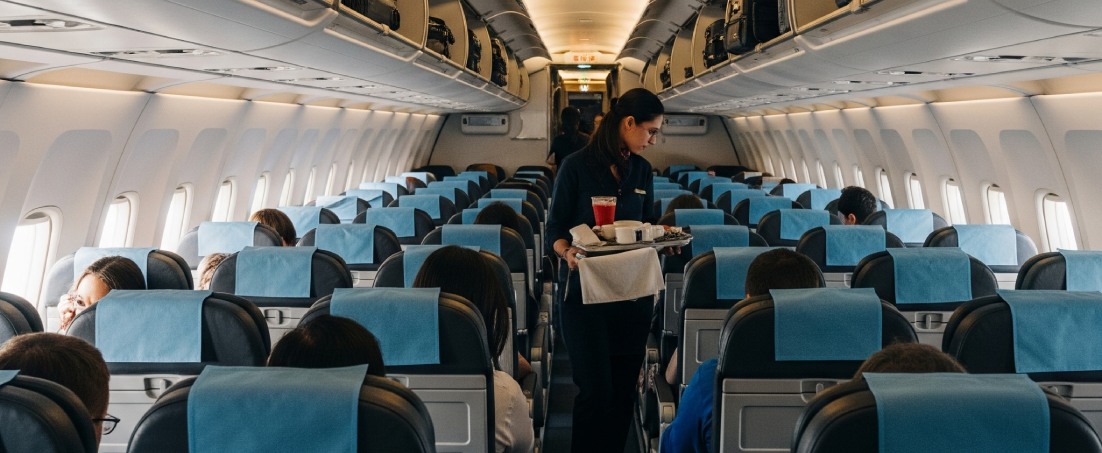The Evolution of Aircraft Cabins: From the 1920s to Today (and Beyond)

Once upon a time, flying wasn’t just transportation — it was an event. People dressed to the nines, sipped cocktails at 35,000 feet, and stretched their legs without elbowing a stranger. Over the past century, aircraft cabins have transformed from chilly, noisy boxes to high-tech comfort pods (and, yes, in some cases, glorified sardine cans).
Let’s hop decade by decade — tray tables stowed, seat backs upright — from the roaring 1920s to the not-so-distant future.
In the early 1920s, airplanes weren’t built with you in mind — they were built for mail. If you were lucky enough to snag a passenger spot, you might find yourself on a Ford Tri-Motor: 12 seats, an aisle barely wide enough for a human, and an interior that looked suspiciously like a train car.
Cabins weren’t pressurized, so flights stayed low, bumpy, and breezy. Heating? That’s what your wool coat was for. Still, for the wealthy few, even a short hop at 110 mph felt like a luxury.
By the 1930s, airlines realized that selling seats required selling comfort. The Douglas DC-3 changed the game: bigger, faster, and with cabins you could actually recognize today — overhead bins, plush seating, and windows that were more than tiny portholes.
And then there were Pan Am’s Boeing 314 Clippers — giant flying boats with lounges that transformed into dining rooms. Passengers dined on gourmet meals served by tuxedoed stewards, sometimes in a “Bridal Suite” at the back. Flying wasn’t just travel. It was bragging rights.
The Boeing 307 Stratoliner brought pressurized cabins, meaning planes could cruise at 20,000 feet — above most of the bumps and clouds. No more chewing gum for turbulence-induced panic.
World War II slowed civilian flying, but postwar surplus military aircraft like the Lockheed Constellation became luxurious long-haul rides. Transatlantic flights now had style and speed.
In 1958, the Boeing 707 roared into service, slicing travel times and introducing a new kind of cabin experience. Think spacious aisles, six extra inches of legroom, and cocktail lounges on board.
Flying was still expensive, so passengers dressed like they were going to the opera. Lobster, steak, champagne — all part of the in-flight menu. The term “Jet Set” wasn’t just clever branding — it was real life.
Cabins in this era were playgrounds for the well-heeled. Upper decks on the Boeing 747 had piano bars, and Concorde promised you could breakfast in London and lunch in New York (at 3.5 hours per crossing).
Entertainment arrived via pneumatic headphones that looked like medical devices, offering music “channels.” Smoking was still allowed, and many airlines encouraged mingling. (Yes, you could literally walk around mid-flight without bumping into five people.)
Deregulation brought competition — and tighter economy seating — but also new products like Business Class. You could get extra legroom, better meals, and more privacy without paying First Class prices.
Seatback TVs appeared, letting you watch movies without craning your neck toward a shared screen. Lie-flat beds became a thing — for the premium crowd — while economy kept shrinking.
By the 2000s, every long-haul seat seemed to have its own screen. Airlines introduced Premium Economy, the “Goldilocks” class between sardine and splurge. Wi-Fi began creeping into the sky.
British Airways made flat beds in Business Class standard, bassinets became more common for babies, and passengers started to expect tech at every seat.
New aircraft like the Boeing 787 Dreamliner and Airbus A350 improved cabin air, humidity, and lighting — all in the name of reducing jet lag.
Meanwhile, First Class went full luxury: private suites, showers, personal wardrobes. At the same time, economy kept losing inches — down to 30–31 inches of pitch on many planes. (Hope you like making new friends. Very close friends.)
Today’s cabins are sleeker, lighter, and greener. LED mood lighting, antimicrobial surfaces, and better air filtration are standard. Some airlines are experimenting with AI meal service, modular seating that can reconfigure mid-flight, and immersive entertainment that goes way beyond a screen.
Coming soon:
Flying may never again have the champagne-soaked glamour of the 1960s, but the cabins of tomorrow promise to be smarter, greener, and more personalized than ever.
From rickety mail planes to AI-powered suites, the cabin has evolved in ways early passengers couldn’t imagine. One thing hasn’t changed: that little thrill when the engines roar, the wheels leave the ground, and you realize — you’re flying.